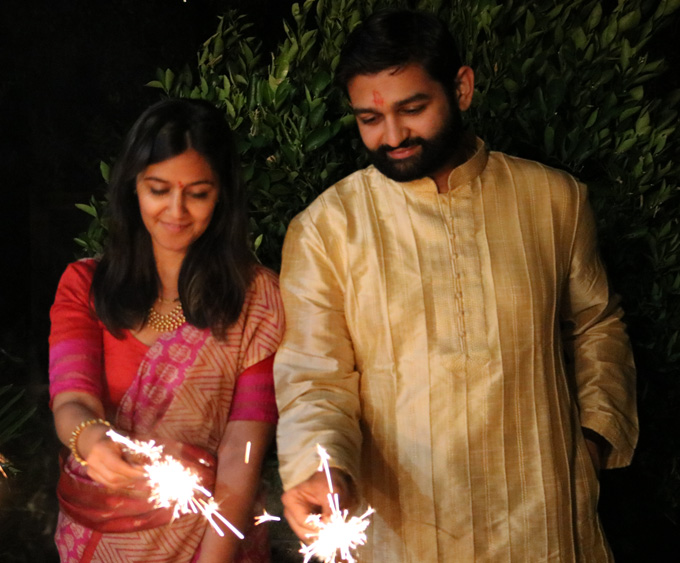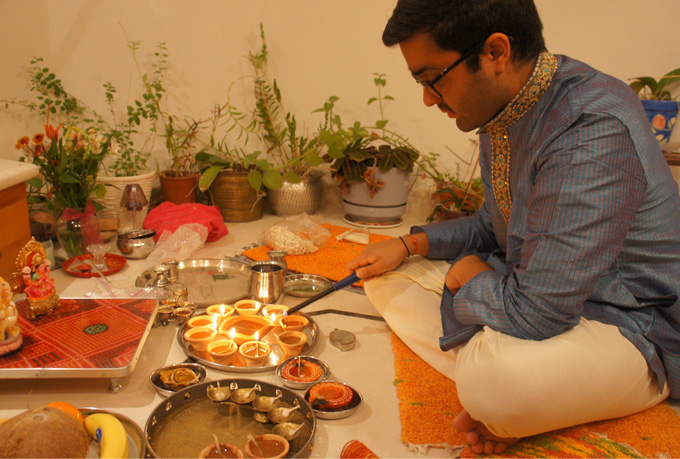Festive: Diwali Delights
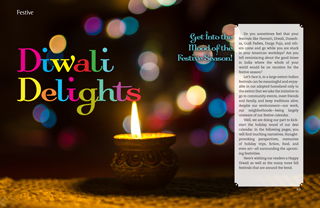
Get Into the Mood of the Festive Season!
Do you sometimes feel that your festivals like Navratri, Diwali, Dussehra, Gudi Padwa, Durga Puja, and others come and go while you are stuck in your American workdays? Are you left reminiscing about the good times in India where the whole of your world would be on vacation for the festive season?
Let’s face it, to a large extent Indian festivals can be meaningful and enjoyable in our adopted homeland only to the extent that we take the initiative to go to community events, meet friends and family, and keep traditions alive, despite our environment—our work, our neighborhoods—being largely unaware of our festive calendar.
Well, we are doing our part to kick-start the holiday mood of our desi calendar. In the following pages, you will find touching narratives, thought-provoking perspectives, memories of holiday trips, fiction, food, and even art—all surrounding the upcoming festivities. Here’s wishing our readers a Happy Diwali as well as the many more fall festivals that are around the bend.
CONTENTS BELOW: A FESTIVAL BONANZA FOR
READERS…AND CELEBRANTS:
1) Delivering Diasporic Diwali Dreams
a nostalgic essay on Diwali in America, by Dr. Rajesh C. Oza
2) a remembrance on
The Legend of Vaishno Devi, by Dr. Monita Soni
3) The Gift of Memory,
a reflective piece on a cynical girl’s discovery of Diwali, by Preeti Hay
4) A Dash of History and a Dollop of Love:
a Foodie's Review of Lakshmi's Table,
recipes for the festival season, by P. S. Lakshmi Rao, reviewed by Maya Harita
5) The Missus' First Diwali,
a short story about a new immigrant, by Nandita Godbole
and even
6) What the Festive Season Means to Me,
a perspective on what this time of the year means to an American convert, by D. B. Dillard-Wright.

1) Delivering Diasporic Diwali Dreams
DR. RAJESH C. OZA gives a nostalgic family history of how Diwali has evolved for him, both in his appreciation of this joyous holiday and in how the appreciation has been delivered to loved ones through different mediums. His parents moved from the South Asian subcontinent to the North American continent in the mid-1960s, never to again celebrate Diwali in the country of their birth. But over the past 50+ years, they’ve never failed to light diyas, do pujas, enjoy mithais, and convey Shubh Diwali to their loved ones.
Bombay Baby and Calcutta Maybe
Although my parents had a comfortable life in
Bombay (not yet called Mumbai by English newspapers),
Papa left for Ontario, Canada, in early 1965 as a
scout of sorts, to get a lay of the snowy-white new land
that would pave the path to prosperity. Mom stayed
back in Mulund, Bombay with her four children, awaiting
the green light to move the family across the kala
pani, the dark waters that her father insisted would result
in familial fracture. While that feared fracture never
quite happened, India and Pakistan fought yet another
of the subcontinent’s internecine wars which ended
days before Diwali, 1965. With our parents separated
by an ocean, my brothers, sister, and I tried to make
sense of our changing world: windows of our apartment
flat in Mulund were darkened with brown paper
to ensure that Pakistani fighter planes could not see the
light inside our home; my elder brother, who was then
not yet ten years old, had to fight his way home from
school one day when all the trains and buses stopped,
causing great worry for Mom; and my five-year-old self
fought with inner demons at night as I would sleepwalk
throughout our 3rd-floor flat looking out of our
balcony for my absent father.
I imagine that Papa and Mom telepathically communicated all these troubles along with their more hopeful visions in the way of young people in love separated by long distances.
After the war was over, on the eastern side of India that makes the shape of its map look like a woman holding a sari aloft on her outstretched arm, there was a girl about my age who was celebrating Dhanteras, the first day of Diwali. While the rest of her family members in diya-lit Calcutta had their eyes closed during the Lakshmi puja, praying to the Goddess of Wealth, this bold lass saw her mother’s jewelry on a silver tray and quietly hid the jewels so as to protect them from anyone who might not be a well-wisher for the family’s prosperity. But as open as that girl’s watchful eyes were, they could not have been as open as my own eyes when Mom prepared me for our flight to Canada.
Canadian Cold
Our stay in Chatham, Ontario was a makeshift one,
with the only other South Asian family in our town
being the Hasnains from Pakistan. As such, in those
early years there were no Indian grocery stores close
to home, though an uncle in a nearby town owned a
French-Indian restaurant. My memories of Diwali celebrations
in Chatham are blurred by the struggles of
my parents making their way in the world. Both would
work multiple jobs including picking tomatoes as farm
hands, Mom sewing clothes as a tailor, and during an
economic downturn, Papa, trained to be a procurement
manager, was laid off from his multinational firm and
took on odd jobs as a security guard and then as an
orderly at a mental hospital. All I can really remember
about India was the pavilion at Expo 67 in Montreal and
blue aerogrammes to and from family back home in Rajasthan.
For those of you not old enough to know about
aerogrammes, following is a default template that we
would follow:
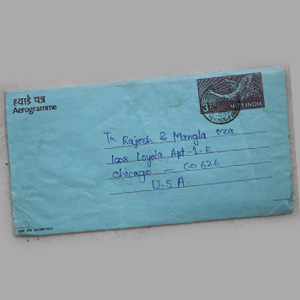
(left) The aerogramme, now a relic, was once the staple of communication for immigrants, keeping them in touch with loved ones back home. Receiving and sending one was a momentous event, especially during festivals like Diwali.
• The aerogram—a thin, lightweight piece of blue paper approximately the size of a standard printer paper, 8.5” x 11,” was folded into three sections as if you were enclosing it in an envelope.
• The top fold was for parents to pay respect to elders in India, write that “all izz well” in Canada, and for special holidays wish everyone “Happy Diwali,” “Happy Holi,” or “Happy Raksha Bandhan.” Just keep things joyous, suggesting that Goddess Lakshmi is smiling upon us in this land of milk and honey. Hidden from family in India were the hardships, the hard facts of our cold Canadian Diwali: no time with an uncle who was too busy with his restaurant, no agarbati to fill our home with sandalwood incense, no exploding firecrackers to let neighbors know about “our Christmas,” no flickering diyas to guide Lakshmi to our home, no shining jewelry or dhan except the maple-leaf pennies that my parents earned; all we had were the six of us performing the puja around a silver coin of Lakshmi safeguarded from India, our foreheads dotted with kumkum powder carried in Mom’s suitcase as a vermilion reminder of our ancestry, and our mouths sweetened with saffron-less rice pudding pretending to be kheer with wrinkled black raisins substituted for plump golden ones.
• The middle fold was for more serious matters: replying to previous requests to send more money; sharing news about children’s educational accomplishments; and deferring the visit home to Rajasthan with a “we will soon return when we have accrued enough vacation” (while never disclosing that Goddess Lakshmi’s smile had been a bit pinched, and we didn’t have funds for tickets to fly back to India; the illustration of an airplane on the front of the aerogramme was as close as we would come to a flying machine for almost a decade).
• And squeezed into the bottom fold on the inside of the aerogramme was space for the elder two siblings to write their pranams; inevitably the respectful salutations bow down to the end of the page and climb over to the other side where the younger two siblings (my younger brother and myself) wrote in larger font to grandparents, uncles, and aunts whose fully-fleshed memories slipped away into two-dimensional black and white photos.
• Lastly, the address section on the front had Papa’s confident upper-case hand-written memory of his or Mom’s village homes, before the gummy edges of the paper were moistened with parental saliva, pressed together, and the aerogramme was dropped in a mailbox.
Chicago Communities
After Papa was laid off from his job, he explored
an opportunity in Chicago. In 1969, the same year that
Apollo 11 made like a powerful Diwali firecracker and
rocketed the first men to the moon, our family made
like Diwali phuljharis and sparkled our way to the United
States. While the Windy City was as cold as Ontario,
its Midwestern heart felt so much warmer. Cosmopolitan
Chicago had universities with graduate students
from India, had a group of Gujarati friends that reminded
Papa of Pravin Parikh, his best friend in Bombay, had
a Patel Brothers grocery store to cater to the growing
Indian population, and even had a Hindu temple.
In Chicago, Mom found other women who wore saris everyday, just as she had in Canada and would continue to do for decades in the United States. But these were not Indian women whose jet-black hair flowed down to their waists over the saris’ pallu. They were fair-haired wannabe gopis of the ISKCON movement. But no matter, my parents had a temple, albeit a temple shared with former hippies chanting “Hare Krishna, Hare Rama.” And we had a place to go on Diwali, before returning home to feast with newfound friends and dance in dandia circles.
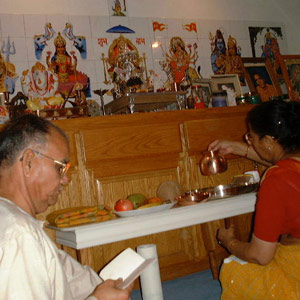
(Left) The author’s father, Chhaganlal, and mother, Vijayalaxmi, doing Lakshmi Puja.
Just as Papa and Mom built an Indian community that enabled them to recreate a semblance of what they had left behind, their children turned toward another community, playing baseball with our American friends and singing rock-and-roll songs that our parents did not appreciate. Filial piety demanded that we attended family pujas, but while Mom and Papa celebrated Diwali with their friends, we rolled our eyes during prayers and began to surreptitiously make fun of our parents’ friends’ funny clothes and oily hair, and, out of adult earshot, mimicking the thick Gujarati accents in a way that presaged Hank Azaria’s diminishing Apu character on The Simpsons by a couple of decades. We were becoming defiantly Americans while steadfastly remaining loyal to, and protective of, our parents’ core values.
As the years went by, it appeared that Yankee defiance might win out: Blue jeans left no space in our closets for kurtas and pyjamas; Hollywood pushed Bollywood into the distant background; and for a while it seemed that television families like The Brady Bunch were the norm that we aspired to. The so-called “boob tube” delivered cultural context and our Americanized tongues became more comfortable saying “Happy Thanksgiving” rather than “Shubh Diwali.” While my parents did not overtly show anxiety around cultural loss, it must have seemed to them that their Diwali diyas could not hold a candle to Nat King Cole’s Christmas lights accompanied by chestnuts roasting on an open fire; while the former was easily extinguished, the latter illuminated much more of our Midwestern zeitgeist.
Silicon Valleys
College was a turning point. The summer before
my freshmen year, our family returned to Rajasthan for
the older two siblings’ weddings. I returned to the U.S.
with a commitment to learn about India, to be more of
an Indian, to never remove my janoi, the sacred thread
with which I had been invested days before my elder
brother’s wedding. At college, only the Indian graduate
students seemed to know anything about our shared
heritage. There were three other undergraduate Indians
in my freshman class, and all of them were on
the right side of the Indian-American hyphen. It was
only through coursework in Indian history, political science,
art, religion, and anthropology that I found my
way to my own Indian identity. And then there was
Satyajit Ray’s Apu Trilogy that clinched the deal with
its masterful cinematic verisimilitude. On my road to
self-discovery, I discovered Pather Panchali, the Song of
the Little Road. I fell in love with village India and with
the Bengali aesthetic. I saw Diwali through Apu’s eyes
in Aparajito (The Unvanquished), the second of these
three classic films. I found a way to vanquish my years
of exile from India.
Upon graduation from college, I returned to India for my own wedding. I married Mangla, that notquite- Bengali girl of Rajasthani heritage who in the mid-1960s had safeguarded her mother’s jewelry on Dhanteras. Through the years, my wife has taught me more about Diwali then all the professors, books, films, and years that preceded her. Like so many mothers before her, and we pray so many mothers after her, Mangla has safeguarded much more than shiny baubles. She has kept alive the traditions of our ancestors and passed them along to our children and their spouses like a treasure that can be held only in one’s heart.
It is true that we no longer wait twelve days for our Diwali letters to cross the ocean and do the postal handshake/namaskar. Yes, we’ve been blessed by all the Silicon Valley innovations like email, Skype, and WhatsApp that enable us to have our Diasporic Diwali dreams delivered to us in an instant. And for those of us who are old-school, we now even have a Diwali stamp should we be inspired to send our loved ones Diwali greetings that consist of more than ephemeral bits and bytes.
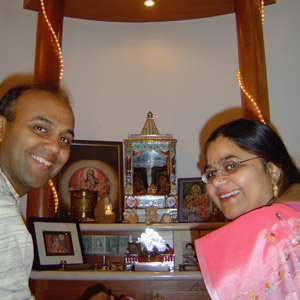
(Left) The author, with wife Mangla, doing Lakshmi Puja.
Of course, the numbers of Indians in North America have gone up exponentially through the years. Unlike my parents and the Hasnain family of 1960s Chatham, Mangla and I have nearly a dozen Indian families living within walking distance from our Palo Alto home, each celebrating their own vision (and each other’s version) of Diwali/Deepavali: North India, South India, East India, and West India all centered around our California abode. Despite our neighborly friendships, our past has its hold on us and we hold on to vestiges of ancestral tribalism with our RANAs (Rajasthan Association of North America), GCANAs (Gujarati Cultural Association of North America), TANAs (Telugu Association of North America), CABs (Cultural Association of Bengal), etc.
|
|
|
|
The author’s daughter, Anu, and son-in-law, Maneesh, sparkling with phuljhari. |
The author’s son, Siddhartha, lighting a diya. |
To be sure, there have been some clunker Diwali celebrations like the RANA function in the early 1990s when I read out loud every word of Vikram Seth’s “Diwali” poem, leading almost the entire audience to head for the food before it was ready (I think Mangla was the only one who listened to my every word). But we’ve come a long way, crossing the bridge between here and there. Here might be Atlanta, and there might be Ahmedabad. Perhaps here is modernity, and there is tradition. And courtesy of our multiple and virtual Silicon Valleys that are anywhere, here and there could be everywhere, facilitating the building of our own Rama setus, our own bridges to (re)discover the loves of our lives. And we merely need a diya to light the sky, to show us the way back home and make peace with our disquieted heart.
Rajesh C. Oza, who for many years wrote Khabar’s “Satyalogue” column, truly hopes one day soon to celebrate Diwali in India, perhaps with a grandchild in tow. As Founder and President of OrganiZationAlignment Consulting Group, Inc., he specializes in helping senior executives better align their organizations to achieve success.

2) The Legend of Vaishno Devi
With Navratri around the corner, the author remembers her childhood visit to the goddess who resides in a million-year-old cave. By Monita Soni
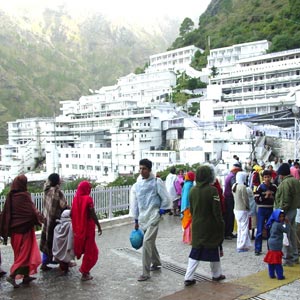
(Left) The Vaishno Devi shrine in Jammu and Kashmir.
A timeless place where Bhairon stumbled and was beheaded by Vaishnavi—for hundreds of years pilgrims have climbed over his head to enter this splintered mountain into a cave, an eternal shrine of purity.
The year was 1972, the longest leap year ever (by two leap seconds). My dad Swadesh Kumar Kapur was a regional manager for Merck India pharmaceuticals and was posted in Amritsar. I was twelve years old. My sister Samita was eight, and my friend Shiwani ten. It was the time when Luna 21 and Apollo 17 landed on the moon and the legendary movie The Godfather was released.
We were renting the front house of the Bhatia Bhavan compound on Hukam Singh Road in Amritsar, Punjab. It was a safe neighborhood, and we often visited neighbors. We knew the aunty who made the best stuffed parathas, the mother who served the tastiest lemon pound cake, and whose mango ice cream was topnotch. Life was good. Sacred Heart school did not overburden us with homework. Afternoons were full of hide-and-go-seek, jump rope, seven-stone (pithoo), land-or-water, and culling raw mangoes.
Along with birthdays, we kids looked forward to the Kanjaka ceremony, on the eighth day of the Navratri festival (Ashtami). At this celebration of Goddess Vaishno Devi, young girls were special guests. Not only did we get mouthwatering snacks of puri, aloo-chhole, and halwa, but we also received shiny coins, colorful bangles, parandis (ribbon-like hair ornaments), and dupattas. My mother would sow khetri (wheat) in a pot and water it with love and devotion every day for nine days. On Ashtami my dad washed our feet; we were offered flowers and Mata’s prasad. We sang “Jai Mata Di” with gusto and ate our prasad. The taste of mom’s freshly made halwa-puri still lingers in my mouth.
Dad organized a pilgrimage to Vaishno Devi. The pilgrims were Kapurs, Bhatias, Sehgals, Peshawarias, and the kids. The goddess’ shrine is about 250 km from Amritsar. It took us 5-6 hours by the Punjab Roadways deluxe bus to Jammu, the winter capital of Jammu and Kashmir. You can also take a train from Delhi or Kalka to Jammu. Then a local bus drove us 1-2 hours from Jammu to Katra, a small bustling town on the banks of the Banganga River. My ears are still ringing with the shrill horn the driver used at every turn, but this auditory infliction on the passengers’ ears was a much-needed built-in safety device to avoid collisions on the treacherous mountain road. Our mothers were knitting; Dad was reading; and the girls were busy playing games. There were no laments of “Are we there yet?”
After resting in a clean dharamshala (guesthouse), next morning we marched single file behind Dad. Our shoes laced, faces eager in anticipation for this adventure, we were ready to see Vaishno Devi. First, we spilled into a quaint shudh bhojanalaya (breakfast place—no eggs or chicken here; the goddess is Vaishno—pure vegetarian) and curved around a large wooden counter to watch the cook fry hot parathas on a giant griddle. After downing our parathas with tall glasses of steaming warm milk or hot tea, we swung out in a semicircle holding hands, commenting on an eclectic community of monks and pilgrims from all over the country. My sister Samita (the youngest) had to be rescued a few times as we zig-zagged through fluttering kits of pigeons, docile droves of donkeys, lurking troops of cheeky monkeys, and stubborn holy cows.
Dad had related the legend before we embarked on our trip. Vaishno Devi is a Vaishnava goddess, the Yog Maya of Vishnu, and a manifestation of the Hindu Mother Goddess Mahalakshmi. Worshipped as Mata Rani, Trikuta, and Vaishnavi, she resides in a holy cave or bhavan in the three-peaked mountain Trikuta, at 5,200 feet. This is not one of the shatipiths (energy-sources), but it is an ancient shrine mentioned in the Rig Veda from the Puranic times. It was discovered 700 years ago by Shridhar, a Mata devotee. Now it’s is the second most visited temple in India (second to Tirupathi in Andhra Pradesh).
Our 12 km trek up the mountain began. My sister was hoisted piggyback on a porter or pithu. The rest of us were on our feet. No palkis (palanquins) or mules for us.
At halfway point or Adhkuwari, Dad told us that Lord Rama, the seventh incarnation of Vishnu, in 7306 BC during his fourteen-year exile, happened to visit Vaishnavi. She recognized him immediately and asked him to accept her so that she could merge into the supreme creator. Lord Rama, knowing that it was not the appropriate time, dissuaded her by saying that he would visit her again after the end of his exile, and at that time if she succeeded in recognizing him, he would fulfill her wish. True to his words, Rama visited her again after being victorious in the battle, but this time in the disguise of an old man. Vaishnavi was unable to recognize him. She was distraught. Lord Rama consoled her, saying that her time would come in Kaliyug when he would be in his incarnation as Kalki.
After Ardh Kumari there was a steep climb to Hathi Matha, a large rock shaped like an elephant head. Views on this stretch were panoramic but the climb steep and scary, for if you slipped you would hurtle 4-5,000 feet down the side of the mountain into the valley. I took a minute to hurl a pebble but could not gather the courage to look down. Many landslides occur and have caused a few tragedies, but we kept trekking on, encouraged by the chants of “Jor se bolo Jai Mata Di.” Now you can take a helicopter ride from Katra for 700 rupees.
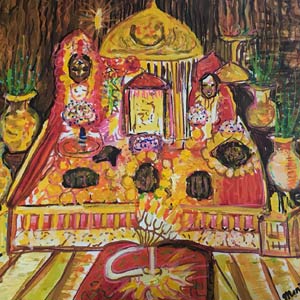
(Left) The author’s rendering of the Mother Goddess in the sanctum of the holy cave. (Painting by Monita Soni)
At the culmination of their pilgrimage, we were blessed with darshan (viewing) of the Mother Goddess in the sanctum of the holy cave. She is in the shape of a five-and-a-half-foot rock with three rock heads or pindies that represent the holy trinity of goddesses Vaishno, Kali, and Lakshmi. The cave entrance was narrow and we had to crawl into the cave, and our feet were numb from stepping in the freezing waters of the river Banganga. I remember holding my sister’s hand in the dark cave lest she be swept away in the river. A pilgrimage to the Holy Shrine of Shri Mata Vaishno Devi Ji is considered to be one of the holiest pilgrimages of our times. She is known as “Moonh Maangi Muradein Poori Karne Wali Mata,” she who fulfills her children’s every wish. I wonder what my parents wished for. I wished for the health of my family.
As I think of this special pilgrimage, I know that this Ashtami I will read the story about Mata Vaishno Devi being an embodiment of Maha Kali, Maha Lakshmi, and Maha Saraswati to my grandson Ayush. The three divine energies coalesced their spiritual prowess into a beautiful young girl born in the Ratankar family in South India. From childhood she displayed an unquenchable quest for spirituality. I will tell him how Vaishnavi looked inward for self-knowledge and learned the art of meditation, relinquishing household comforts and going deep into the forest for meditation. I am sure we will both hear the fervent chants of devotees and my Dad singing a bhajan in his beautiful voice: “Na main dhan chahoon, na ratan chahoon” from the film Kala Bazaar. Dad was a true devotee who did not ask for money or jewels but a refuge at the feet of the goddess, and his wish was granted. True treasure is a good heart, the only thing the soul can carry with it beyond the cycle of life and death.
Back at base camp, Dad completed his story. As predicted by Lord Rama, Vaishnavi’s glory spread far and wide, and devotees flocked to her ashram to seek her blessings. One day MahaYogi Guru Goraksh Nath became curious of Vaishno Devi’s spirituality. He sent his disciple Bhairon Nath to probe the truth. Mesmerized by Vaishnavi, resplendent in red garments, armed with bow and arrows, and riding a ferocious lion, Bhairon Nath began to pester Vaishnavi to marry him.
At that time Sridhar, a prominent Mata devotee, had organized a bhandara (community meal) in which the whole village and Guru Goraksh Nath and his followers were invited. Bhairon Nath attempted to grab Vaishnavi, but she fled into the mountains. Bhairon Nath chased her to the holy cave, where the goddess was compelled to behead him. His severed head fell on a distant hilltop. Realizing the futility of his mission, he prayed to the deity for forgiveness, and the merciful goddess granted him a boon—that every devotee would have to have darshan of Bhairon after having darshan of the goddess, and only then would the pilgrimage be complete. Vaishnavi then shed her human form and merged into a rock for meditation forever.
We were not conditioned to take this mountainous journey, but with Dad’s planning and encouragement we made the daunting 24 km roundtrip trek safely. Our legs felt full of lead. The most excruciating leg cramps I have ever experienced were the day after the trip. How I wished I had actually played tennis rather than just pick tennis balls for the famous IPS officer Kiran Bedi (then Peshawaria) and her fiancé Brij Bedi. My wish was granted, too: my calves have not hurt that much ever since. Jai Mata Di!
Monita Soni is a pathologist who diagnoses cancer in her day job. Reading and writing poetry is a passion that splashes her literally with a sparkling abundance. You can hear her commentaries on “The Sundial Writers Corner” on WLRH 89.3 FM/HD, Huntsville, AL.

3) The Gift of Memory
A cynical little girl’s journey to find meaning in Diwali. By PREETI HAY
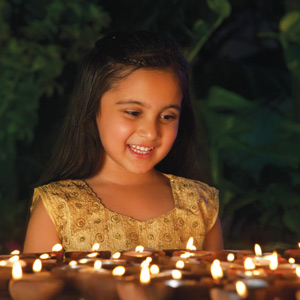
There was a little girl who hated all festivals and would rather have spent her time reading Enid Blyton. Holidays annoyed her: the social expectation, the opulence, the pressure, even the overeating. It was most importantly the disruptions that festivals imposed on the monotony of her own life that she could not stand. Why couldn’t life just be boring enough so she could spend her time writing and daydreaming about being a writer? Poor kid, she had no idea that life and memories create stories, not the lack of them. That little girl was me.
I grew up in Bombay, an only child in a family that was odd, as all families can be. My paternal grandparents whom I adored, came from the Brahmo Samaj school of thought, and hence, were pretty much indifferent towards traditional Hindu festivals and celebrations. My father was rather unenthused, except for binging on mithais, especially as midnight snacks. It really was my mother who adored festivals! She grew up in the foothills of the Himalayas in Dehradun. Marriage had brought her to Bombay. Even though she loved the freedom and pace of the southwestern city, she sorely missed the grandiose and collective excitement of festivals from her north Indian childhood in Dehradun. So she’d skip the insipid festival time with a family of “garlic faces” and escape to Dehradun for Diwali every year.
We boarded the Dehradun Express for our two-day journey. Looking back, I feel pity for my mother having to accompany me, a jaded little girl who had not made up her mind about festivals. How would I? I felt equally pulled in two directions, in a constant tug of war between the Yay and Nay camps. On the ride over, as she chattily prepared me for the big event (crackers, pujas, dinners, card parties, and exclusive extended family time!), I buried my head in Nancy Drew novels. She reminded me of names of second and third cousins, as I made reluctant mental notes lest I offend anyone. Over the two days, we spent quality mother-daughter time over spotting peacocks in the Rajasthan landscapes, having special milk in Baroda, eating puri bhaji in Ratlam, and watching the ruggedy sadhus in Mathura. Looking back, that train ride was so quintessentially India in all its hot, chaotic, and messy splendor.
When we got off in Dehradun, we were a tired, dusty mess. Arriving in the chill of the morning fog at my maternal grandmother’s home, Bibiji (that’s what I called her) was waiting at the verandah door with big hugs and hot, cream-layered chai. All the cousins were on Diwali vacation and came over to see us that morning. They called my mother Bombay Bua and I was Bombay Didi. They were completely fascinated with my Bombay Hinglish just as I was with their fast-paced, purist Hindi.
We zipped around downtown Dehradun on mopeds buying mithais and gifts such as suit pieces and saris for aunts and farsaan or chocolates for uncles. For cousins we always bought firecrackers. Each child had a set limit of firecrackers they were allotted by their parents. Anything additional could come only as a gift. My allowance was Rs. 100. To my little mind, that was a huge amount and for once I was very excited. In my imaginary tug of war, the Yay camp won this particular battle.
One year, on Diwali night, a burning chakri somehow hopped over loops and landed straight on my foot. I shrieked in terror as the whole family brushed it off my foot, then poured numerous bottles of water on the affected area. I was carried back into the house, away from the festivities. As I lay in the solitude that I had always hoped for during Diwali, a little part of me missed the lights, the laughter, and the feeling of being part of a whole. While everyone still rejoiced, my grandmother Bibiji nursed my wound and sang me to sleep amongst the noises of the night.
Bibiji had mothered and raised eight children and grandmothered seventeen! Her matriarchal commitment to the unity of the clan across individual differences made her a prime figure in my mother’s family. Her strength to know when to give in and when to stand up for herself was interesting to watch as a little girl. Towards me, she was not all rosy; she reprimanded me for bad behavior, she was frank about my fussiness when it came to food and manners, and yet she indulged me in ways she found appropriate. As a little child, I could not appreciate her wisdom. I judged her and at times tried getting back at her.
Every year for Lakshmi puja, it was the family tradition to write the names of all men in the family who would carry forward the family name and lineage. That year was a special Diwali because four boys had been born into the family—any Indian grandmother’s dream! Her wall seemed fuller that year as she added the new names to the list. She also bought a special gold idol of Baby Lord Krishna in a baby swing to commemorate the occasion. Somehow the focus on the boys and the play of events upset me. So I surreptitiously added my name to the list. Bibiji simply erased my name from the list; women did not belong on the list. With the vengeance of an ignorant child, I went back and threw her baby Krishna idol on the floor. The echo of the now broken idol resonated all over the house. I was reprimanded, cursed, and spanked. This could not be a good omen. Bibiji did not say a word. After the dust settled, she went about her puja, held the integrity of Diwali, and we never talked about it again. Looking back, her actions surprised me. She looked forward to that day for years and I had destroyed it in a few minutes. She taught me to be able to be around things and situations without agreeing with them. It is good to question things, but sometimes, for the sake of others, it is better to let go—a lesson I still value and try to use in my adult life at home, work, and larger community.
Bibiji passed away the year after. That was our last Diwali together. I never could apologize and tell her how much I learned from her. Diwali was never the same for my mother and me. We started skipping years and within a few years my mother died most unexpectedly as well. With her passing, Diwali and its joys were over for me. I never could bring myself to go to Dehradun for Diwali again, even though I did visit at other times. It was due to our yearly Diwalis together that I became close with my cousins and still am.
Now in America, years later and miles away, what do the holidays involve? Family, love, gifts, shopping, exhaustion, credit card debts, post festivity dieting, and failing at it! After my careful lists, I have concurred that the greatest gift of festivals is memories. During Diwali every year, I have flashes from those cold October and November nights of celebrations in Dehradun: images of chuckling little cousins jumping at the sight of anars, having rasmalai-eating contests, waking up with tummy aches after, and winning and losing our child fortunes in gambling games past midnight. Now, I am thankful for those times.
As my son turns two this year, the cynic in me wants to take a backseat for his sake. I want his festivals to be full of light, joy, hope, and prosperity, everything they truly represent. His fate I cannot decide, but what I can do for him is to create memories, the greatest gift of festivals.
Preeti Hay has a Master’s degree in English Literature and a Bachelor’s degree in Mass Media. Her articles have appeared in publications including The Times of India, India Currents, Yoga International, Yogi Times and anthologies of fiction and poetry.

4) Cuisine: A Dash of History and a Dollop of Love:
a Foodie's Review of Lakshmi's Table
The book is more than just a collection of recipes. It’s a testament to the author’s determination, as a pioneering immigrant in the 1960s, to recreate in her new country the unparalleled legacy of the South Indian food traditions she had left behind. By MAYA HARITA
Cooking. Some call it art, some claim it as passion, some do it as a hobby, and for others, it is just a necessity. My favorite description is from a good friend who once defined the art of cooking as “an offering of love.”
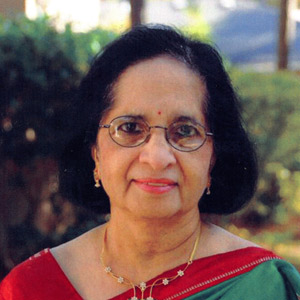
(Left) The book's author, Mrs. P. S. Lakshmi Rao.
Lakshmi’s Table, a book I was recently tasked to review for Khabar magazine, is one such offering of love. While I am captivated by the cookbook itself, my encounter with Mrs. Lakshmi Rao, the book’s author, her life experiences, and approach to food has become a profound inspiration for me, both in my kitchen and in life. Mrs. Rao, I found out, is no stranger to the Indian community of Atlanta. She and her now deceased husband, Dr. P. V. Rao, were amongst the pillars of the Indian community that was just starting to form in the 1960s. She has been publishing a food column in NRI Pulse, the local desi newspaper, for a few years now.
I met with Mrs. Lakshmi on a beautiful, warm Atlanta evening. In the few hours that we chatted, I was mesmerized by her deep understanding and knowledge of Indian and other cuisines. She radiated a warm, kind, and humble spirit infused with effortless humor.
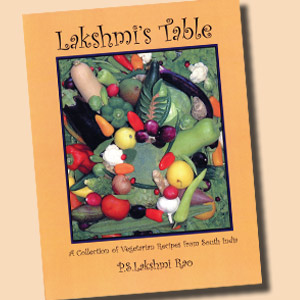
While the book Lakshmi’s Table was published in 2012, the journey of Mrs. Lakshmi’s own table started back in 1961. That year, a young Mrs. Lakshmi and her toddler from the village of Kumaradevam, West Godavari District in Andhra Pradesh, boarded one of the first 747 flights ever built to join her beloved husband, Mr. P. V. Rao in Eugene, Oregon, a researcher who would eventually become a renowned nuclear physicist.
It was in the small town of Eugene that Mrs. Lakshmi began a lifelong journey into experimenting and offering food. She reminisces that, with no Indian stores around and not even the basic dals, spices, and pulses available, she used to get freshly baked French bread from a nearby bakery to have along with her soups made of yellow split peas and sautéed vegetables. Have you ever felt hungry when some people talk about food? Mrs. Lakshmi is most definitely one of those people.
The cookbook itself was written out of her passion for making authentic South Indian food. But there’s even more to Lakshmi’s Table. The recipe collection is a happy blend of the conventional items cooked by generations of Indians, along with tantalizing surprises like Zucchini Curry, Stuffed Brussels Sprouts, Yellow Squash and Bell Pepper Curry, and Cranberry Yam Chutney, to name a few.
Recipe writing is an art in itself and here, too, Lakshmi’s Table aces it with well-organized sections and easy-to-read-and-follow preparation methods.There are helpful tips and variations as well, to help one achieve the right flavor and consistency.
The book begins with Snacks and Appetizers, quite appropriately, like the start of a grand meal. The Black-eyed Beans Wada, Chegodies, and Mung Murukulu are one-of-a-kind appetizers that are quick, easy to make, with a nice, creative touch.
Mrs. Lakshmi’s long list of chutneys, with well measured proportions of ingredients, is a testament to how important chutneys are to a meal. There are traditional favorites like Ginger Chutney and Gongura Chutney, as well as unique ones like Cranberry Yam Chutney. She offers fun variations to try out, too. For example, add sesame or ajwain seeds to Ginger Chutney, she says, and you have a cool, new stuffing for bajjis.
What is an Indian meal without pickles? Be it a side for the main entrees or to spice up a comfort bowl of yoghurt and rice, just a spoonful of pickles can make a meal divine! Ever since I first browsed the pickles section, I catch myself dreaming of Pulihora Avakayi. Its color, texture, taste, and the bold aroma arising when the hot tadka is poured onto the mango and red chili powder marinade…oh, heavenly! Pickles are melodramatic in nature and they carry a delicate balance of salt and chili spice. One wrong move and you are doomed to a place of self-doubt and depression! Lakshmi’s Table hand-holds the reader through a variety of pickles that are made from scratch, zesty, but not daunting.
There’s an expansive list of dry and gravy-based curries, dals, and soups. Besides time tested staples like Green Banana Curry, Cauliflower Curry, and crowd pleasers like Gongura Pulusu, this section is brilliantly studded with a host of fusion recipes. The Spicy Orange Soup and Cranberry Dal are some truly creative examples that I just couldn’t resist trying out. The enticing aroma of Eggplant Stuffed with Cilantro Leaves (finely blended cilantro, green chilies, salt, and cumin seeds, stuffed into eggplants and pan roasted) bursts through the roasted eggplant plopped on a bed of rice with a hint of ghee.
The scrumptious dessert selection has been curated to appease both novice and experienced chefs—Almond Burfi, Baked Almonds with Honey, and Lavanga Triangles, anyone? There’s also an Ugadi special. With the upcoming fall festival season of Dussehra, Navratri, Diwali, Thanksgiving, and Christmas, the desserts in Lakshmi’s Table offer multiple options to try out.
But back to my encounter with the author herself. Her obvious dedication and love for serving good food was heartwarming. In a time when ideal ingredients were scarce or simply unavailable, she improvised and served wholesome meals to all who sat at her table and perfected her recipes over five decades! I have since read her book several times over. It takes me back to an earlier time when young couples with a rich cultural heritage migrated to a foreign land. For decades, they have endeavored to retain the essence of Indian traditions while assimilating into their new home.
My grandfather, after every meal, would utter the Sanskrit thanksgiving, “Annadata sukhi bhava” (“May the provider of food be well and flourish”). From the days of wood and coal-fired ovens to today’s modern kitchens, generations of Indian parents have been annadatas, when they sit next to their families and guests and serve them home cooked food. There is an intrinsic joy to serving and eating good food. Lakshmi’s Table goes beyond its recipes—it’s also a delectable slice of history!
Maya Harita, a self-proclaimed foodie, also blogs nostalgically about life from a distant past in India.

5) Fiction: The Missus’ First Diwali
A young immigrant wife, longing for the warmth, light, and color of this most beloved of Indian festivals, bravely attempts to recreate a traditional Diwali, in a new and vastly different cultural landscape. By NANDITA GODBOLE
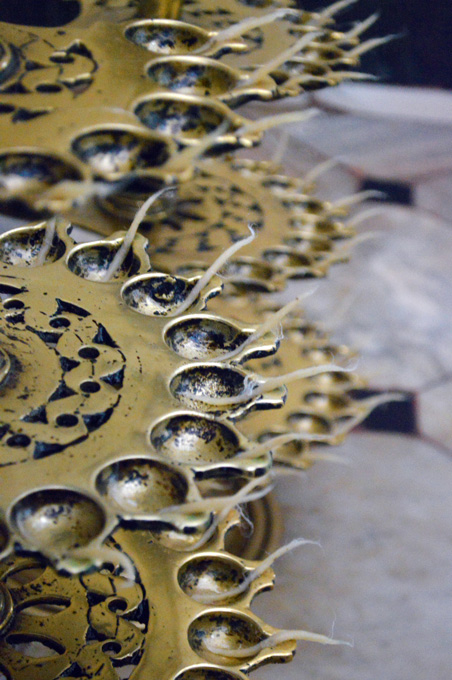
As Diwali inched closer on the calendar, Ana began to see how her ‘first Diwali’ as a married woman would be different in the United States versus if she was ‘back home’ in India.
A ‘back home,’ Indian Diwali meant being guided by elders, bonding with in-laws, shopping for festive finery, being pampered. It was fragrant and deliberate, a pause from the daily grind, when worldly worries took a backseat to family, over five leisurely days.
A traditional Diwali meant cooking treats together and exchanging them with friends. Ana’s mother would make several large bins of Diwali treats, sometimes combining efforts with Ba (Ana’s maternal grandmother) for larger batches. Sooji laddu was her mother’s favorite dish. Spending hours laboring over tender and crumbly laddus, these round globes of roasted semolina were hand-shaped with creamed ghee and sugar. Ana missed sitting with everyone on their kitchen floor, portioning out the sandy mix and attempting to form the laddu in vain. Papa loved chivda and it was a Diwali staple. Diwali meant he got time off; it meant more visitors, and offering them cups of tea and special Diwali treats.
Ana’s maternal grandfather Dadaji sometimes visited to make mohanthal specially for Papa during Diwali and bring Ba’s karanjis. To Ana, they signified the essence of the festival, because they appeared only during Diwali. These crescent-shaped, coconut filled, fried pastries reminded Papa of his mother, his childhood. While his mother’s karanjis were crisp and crumbly, Ba’s karanjis were softer and decadently tender. Regardless, chomping them down meant needing small saucers to catch the crumbs, and then shamelessly dragging one’s finger across it to pick up the last bits of sweetness, the closest permissible way to licking one’s plate clean.
Diwali meant bowing to receive heartfelt blessings of elders, partaking in the iconic joys of indulgent dining, decorating a home with rangoli, lamps, and enjoying fireworks. It meant sharing time: cooking, shopping, decorating, giving and receiving, making memories.
Ana had enjoyed it all. Now, she missed it more.
She and Ravi were far away from family—there would be none of this. Theirs was a love marriage— for some, not an ideal match. If Ana wanted anything special for Diwali, she sensed she would have to shop for it herself. Ravi was too busy to indulge her in rituals. So she planned her first Diwali alone, purchasing a new formal shirt for Ravi, while longing instead for a traditional silk tunic, and finding a new skirt for herself, in place of a formal silk saree, consoling herself that these were practical. She now had token new clothes for Diwali and their Hindu New Year.
“Make at least five festive Diwali dishes, one for each day,” Ana’s mother insisted (over their umpteenth international call). Her simple urging felt like subtle pressure for Ana to take on ‘traditional’ fixings, an assumption that Ana had the skill, patience, or motivation to do it all by herself. Rather than recognizing the confidence her mother felt towards her abilities, Ana felt cornered and alone.
Alone. That hateful word taunted her more often than she cared. Her nostalgia for the festival became tainted with sadness, longing, and a twinge of annoyance at their loneliness. Ana had made practical choices over traditional ones.
Like their love marriage.
Like the clothes she just picked for their special ‘first Diwali.’
The deep divide between what Ana was supposed to do and what was achievable became apparent; the realization scared her and mocked her attempts. She felt a sense of cultural erosion, as though she was cheating while observing a token Diwali, that her traditional Indian Diwali would have to remain tucked away as a memory.
Ana looked up several recipes for chakli, a savory, swirling, crunchy, fried snack that paired with tea, but she did not have the right tools. Ravi’s mother made a boondi laddu: ghee-fried drops of chickpea flour, doused in simple syrup, hand-molded into large globes studded with golden raisins; those seemed difficult to make.
Ana hadn’t realized how much she missed Diwali until she reminisced about it alongside Ravi, who had missed it just as much. She had struggled while taking recipe notes over long phone calls to her mother. Preparing for Diwali alone made everything seem difficult. Sensing her restlessness, Ravi eased the pressure, backing away from special requests: Diwali meant bringing together traditions, not causing worry. They assessed their long list of favorites, reminiscing and salivating over memories of past Diwalis. Ravi offered to make Mysore pak, a warm and earthy stovetop dish that tasted like cardamom-flavored shortbread cookies.
As Diwali neared, they came to terms with what was possible: a puffed rice chivda, Mysore pak, and a date and pistachio log. Ana would make Ba’s ksheera for their Diwali prasad or religious offering, Ba’s own mother-in-law’s laapsi for the pre-dawn New Year’s Day prasad, puri and fruit custard for lunch, and dahi wada for New Year’s dinner.
Ana decided to add something not on her mother’s traditional roster of Diwali sweets, combining plain puffed rice with jaggery into one of her own favorites: a puffed rice chikki. Her mother often made this crunchy bar-like treat as an after-school snack. This easy addition to Ana’s Diwali preparations felt comforting.
Ana’s mother was tickled at the idea, “Surely Ana, you can make something more decadent, something less ordinary.”
Ana wasn’t aiming for decadence but accessible and easy, even if it was ordinary. And yet, there was nothing ordinary about it: it was quite Indian and more importantly, reminded her of family and ‘back home.’
As the furor around Diwali built up inside their little apartment, fiery fall colors took over the town. Apples became cheaper, so Ana attempted making apple pies. She decided to bake one for Diwali, just not as a traditional centerpiece, for the prasad.
Their doorway received a refresher at Diwali: Ana hung a toran, a traditional doorway garland, and christened the doorway with auspicious red vermillion, kumkum, to bless the apartment.
Unfortunately, it raised eyebrows among her Midwestern neighbors. What kind of pagan practice was that? Was that blood? The swastikas—were they anti-Semitic? A letter from the apartment management company arrived. Ana took the toran down and wiped the auspicious swastika and traces of kumkum away.
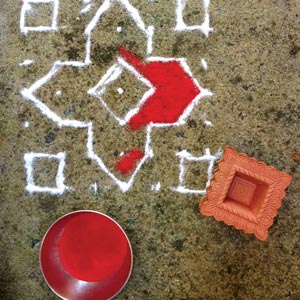
Their first Diwali was quiet. Ravi’s work did not allow him special time off as people in India received. Ana spent all five days of Diwali alone in their apartment, waiting until evenings when they could do something special together.
They lit lamps in the evening but missed the smell of fireworks.
They had made the “eats” but ate alone.
Ana wanted rangoli outside their apartment, but the corridors were carpeted.
Observing such an important religious festival without people who reciprocated their enthusiasm made it feel like a colorless, flavorless celebration; it would not soothe the heartache of missing the love and care of their elders.
So, they did the next best thing: surrounding themselves with memories, through the foods that reminded them of the family they had left behind, of ‘back home.’ In their odd mish-mash of festive treats, observances, and longings, Ravi and Ana made new memories. And just like that, their first Diwali was over, like a much-anticipated yet short-lived meteor shower.
Nandita Godbole is an Atlanta based author of many cookbooks and a food novel. This short story is adapted from her recent novel: Not For You: Family Narratives of Denial & Comfort Foods (2018).

6) Perspective: What the Festive Season Means to Me
By D. B. Dillard-Wright
I came to the dharma late in life as a convert from Christianity, but the more I look back over my life, the more early influences I find that led me to be curious about Indian culture. I spent my early elementary years in Atlanta, near the Greek Orthodox cathedral on Clairmont Road, in the 1980s. I made friends with Neena Ketkar, the Gujarati / Chicagoan girl who moved in across the street, in second or third grade. Most of the time we just rode bikes in a circle on the asphalt, but whenever I went inside her house, Neena’s mom would never let me leave without a sweet. She kept some chocolates on hand just in case a guest would arrive.
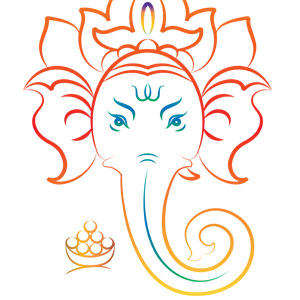
That was also the first time I laid eyes on Lord Ganesha, whose murthi was displayed in a prominent location in the living room of the tidy ranch-style home. When much later, I ate dinner at their house, I remember how the food just kept coming. Neena whispered to me, “Make sure to leave some food on your plate—otherwise she will just keep bringing more.” I still recall the sweet taste of gulab jamun and the way that Mrs. Ketkar reminded me of my own South Carolinian grandmother, who also had a propensity to load down her guests’ plates with food.
When I think about Diwali and Durga Puja, I think about Lord Ganesha and his bowl of sweets that reminds us of the good things in life—the food, shelter, and clothing that we so often take for granted. I also think about the intangible things, like the love that we share with our families and friends. The hospitality that Mrs. Ketkar demonstrated makes all of our lives richer, when we give to one another. Life becomes plentiful when we are generous, as we become less sparing in our desire for a better world. As we perform the puja ritual with offerings of fire, incense, water, food, flowers, clothing, and wealth, we return something back to the devas that they have given to us. This, in turn, reminds us of the cycle of blessings at work both in society and in nature at large. Giving and receiving are intrinsically related: we learn to receive by giving and vice versa. The holidays are a chance to reaffirm our participation in the general flow of give and take that upholds the worlds. My own guruji’s words ring in my ears, “Make sure to give more than you take.”
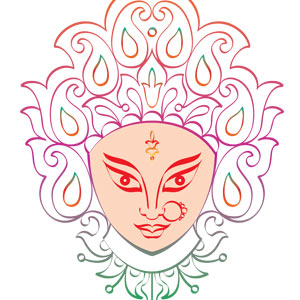
By giving, whether of our time or talents, money or service, we balance the cosmic accounts, making up for any selfishness that we have displayed during the year. We put aside the ways of the past and look for more merit in the year to come, so that we hasten the journey towards liberation. This is the drama portrayed in Rama’s battle with Ravana and in Durga’s battle against Mahishasura: the triumph of the divine soul over the forces of egotism, fear, and doubt.
The scriptures portray the central mystery of human existence: how to live in the material world without succumbing to the myriad temptations that we face every day. I recognize that the word “temptation” might give away something of my Protestant upbringing, but I do think that maintaining a dedication to the spiritual life in our culture of constant distraction can be a real difficulty. But then Durga is the Empress of Difficulties, she who subdues the difficulties. And Lord Ganesha is the Defeater of Obstacles. The devas symbolize the possibility of overcoming all adversity and living our ideal lives despite the forces arrayed against us.
In our fragmented, individualized lives in late consumer capitalism, we can find it hard to connect to tradition and family. It can be difficult to perform home puja or make it to the temple. We get so busy with work and ferrying kids to their different activities that we lose track of meditation and spirituality. There are bills to be paid, to-do lists to complete. But as the holidays approach, let us remember to set aside some time to think divine thoughts and recalibrate our lives towards generosity and goodness. As we give to the gods we also give to ourselves the gift of a respite from busyness and minutia. As we purify the mandir, we also purify our hearts for the divine indwelling.
Despite the general crumminess and corruption of some aspects of our society, we are nonetheless privileged to live in a world in which there is still kindness to be found. We should make it our goal in the year ahead to extend this kindness and make the world a bit less cruel, less uncaring and unthinking. The return of Rama to Ayodhya is the reconciliation of consciousness from division and hatred to unity and peace. May the holidays and the year ahead be a blessing for all beings!
D. B. Dillard-Wright is a professor of philosophy and religion at the University of South Carolina, a former United Methodist Minister, a Hindu by choice, and author of the book, At Ganapati’s Feet.

Enjoyed reading Khabar magazine? Subscribe to Khabar and get a full digital copy of this Indian-American community magazine.
blog comments powered by Disqus




